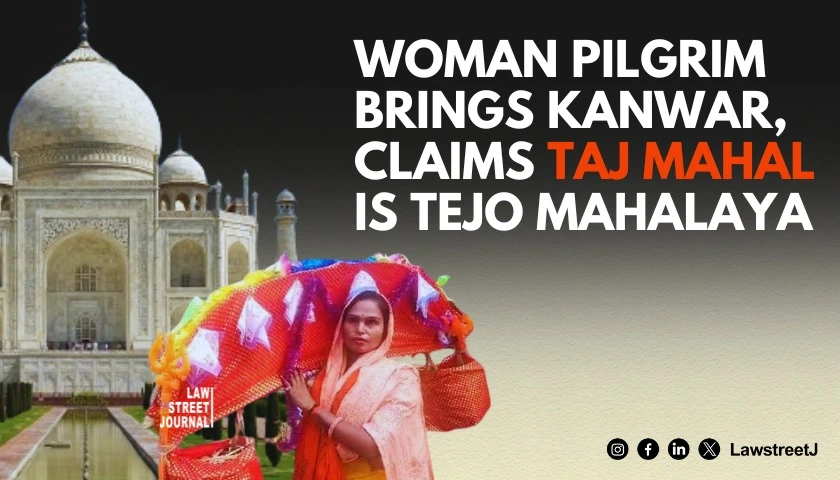As the auspicious month of Sawan unfolds, marked by its significant spiritual vitality, a wave of Kanwar pilgrims traverses the Indian landscape. Their mission: to collect sacred water from rivers and dedicate it at Shiva temples, embodying a ritual steeped in devotion and tradition. However, this year’s pilgrimage harbors a twist that threads through the serene yet potent path of religious fervor straight to the historical gates of the Taj Mahal, where tradition clashes with heritage.
Central to this narrative is a female Kanwariya, a devotee of Shiva, intent on pouring Jal from her Kanwar at the Taj Mahal. Upon arrival, she encounters not the expected sanctity but a barricade of police forces. This stark opposition underscores the ongoing tension between upholding public order and respecting personal religious expressions.
Her pilgrimage transcends the physical, it is anchored in a vision wherein Lord Shiva purportedly directs her to offer her Kanwar at what many believes to be Tejo Mahalaya, a site historically contested and cloaked in layers of mythology suggesting the Taj Mahal's origins as a Hindu temple. Despite her convictions, she is met with the rigid protocols safeguarding a UNESCO World Heritage Site, designated for its Mughal architectural significance and not as a venue for active worship.
Legal Precedents and Judicial Responses
The Kanwariya's assertion, "I have come to offer my Kanwar to Lord Shiva as he called me," collided with the unwavering boundaries of legal frameworks. Historical judgments have consistently influenced the handling of religious claims at the Taj Mahal. In a pivotal 2000 ruling, the Supreme Court of India set a precedent by ruling that no litigation concerning the ownership of the Taj Mahal would be permissible at either local or high court levels, effectively securing the monument’s status under judicial protection.
A woman Kanwar pilgrim approaches the Taj Mahal- Read the Tweet
Adding to the complex legal discourse, a 2015 lawsuit initiated in the Agra civil court by lawyers Hari Shankar Jain and Ranjana Agnihotri, representing Lord Agreshwar Mahadev (Shiva), aimed to have the Taj Mahal recognized as the Hindu temple Tejo Mahalaya. The plea faced strong opposition from the Archaeological Survey of India and the central government, which presented historical evidence of a land agreement between a Rajput king and Shah Jahan for the monument's construction. Ultimately, the court rejected the petition.
Additionally, in May 2022, the Allahabad High Court ruled against a Public Interest Litigation brought forward by BJP leader Rajneesh Singh, which demanded a "fact-finding commission" to probe the presence of "Hindu symbols" on the site and to unlock 22 sealed rooms within the Taj Mahal's basement. The court disparaged the petition, accusing it of trivializing the Public Interest Litigation system.
The Ongoing Debate
This incident at the Taj Mahal, constructed by Emperor Shah Jahan in memory of his wife Mumtaz, not only symbolizes a monument of love but also becomes the vortex of a legal and cultural maelstrom. Various Hindu organizations champion the belief that the site was originally Tejo Mahalaya, a sacred Shiva temple. However, these claims find no confirmation from the Archaeological Survey of India, which steadfastly recognizes the Taj as an Islamic edifice.
The legal backdrop is further complicated by historical petitions to the courts, seeking permissions for performing Hindu rituals at the Taj Mahal. These legal appeals have consistently been met with judicial reluctance, primarily to preserve the secular and historical integrity of the site against evolving religious claims.
UNESCO की विश्व धरोहर स्थल सूची में शुमार ताजमहल पर क्या हैं - Read the Tweet
This ongoing legal and cultural contention not only highlights the individual spiritual quest of the female Kanwariya but also reignites a complex debate over the Taj Mahal's identity. Is it merely a monument to secular history, or does it carry a deeper religious significance as Tejo Mahalaya? The legal system's role in mediating these conflicts underscores the broader dialogue about the rights to cultural narratives and the intersection of faith with heritage in modern India.
As the debate persists, the contours of history, law, and spirituality remain fluid, leaving observers and participants alike pondering the true essence of the Taj Mahal. Is it an enduring symbol of love crafted by a Mughal emperor, or does it stand as a testament to a more ancient spiritual lineage? The answer, veiled in legal and historical ambiguities, continues to elude a definitive resolution, challenging us to reflect on the complexities of cultural heritage and the profound narratives embedded within our shared monuments.















